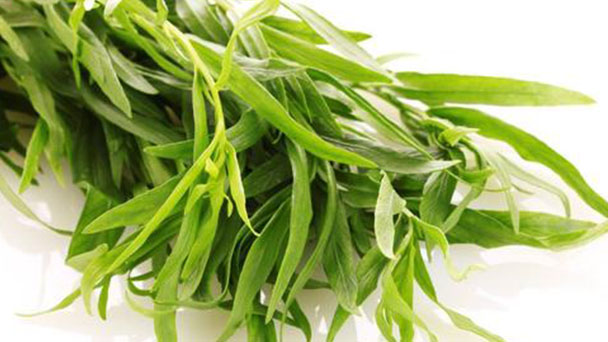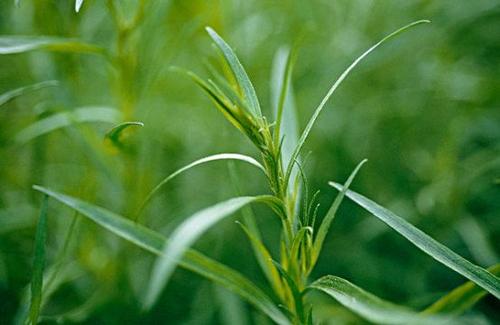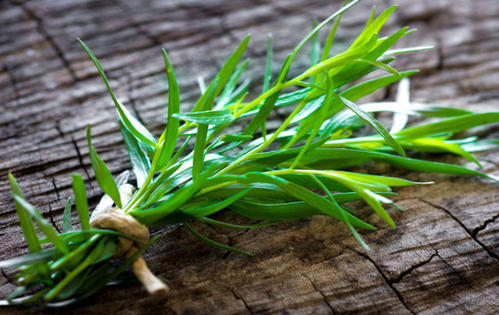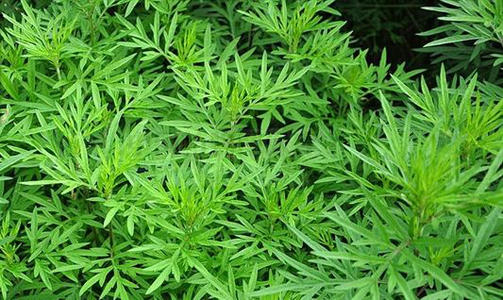Tarragon profile
Written by Maggie
Jan 31 2021

Tarragon is a perennial herb of the chrysanthemum family native to Siberia and western Asia. Tarragon was introduced to Europe when the Arabs ruled Spain.

Morphological characteristics of tarragon
Tarragon is a perennial herb, the whole plant glabrous, taproot thick, long thick rhizome. Stems are erect, mostly tufted, slightly purplish brown, 50 -- 150cm high, middle and upper branches, lower woody. Lower leaves wilt during flowering; Leaves of Tarragon are above middle lanceolate to lanceolate, 3 -- 6cm long and 2 -- 5mm wide, apex acuminate, entire, glabrous, sessile on both surfaces; Upper lobe is small. Inflorescences are spherical, 1.5 -- 3mm in diameter, mostly arranged in spreading panicles on stems, involucral bracts in 3 layers, margins glabrous, margins of 6 -- 7 female flowers, central bisexual flowers more. Achene of Tarragon is obovate, ca. 0.6 mm long, brown.
Origin and distribution of tarragon
Tarragon is originally from Europe. The Tarragon is cultivated artificially in Russia, Georgia, France, Holland, Hungary and California, among which the French cultivation edible history is long, it is one of the famous spices of France.
In recent years, Tarragon has been more widely cultivated. In China, it is distributed in the northwest and Mongolia, and some regions of Russia. It grows on the sunny slopes of mountains.
Tarragon growing methods
Tarragon likes bad soil and happily tolerates drought and neglect. Tarragon is not as strongly aromatic and flavorful as the French cousin, but it will produce more leaves from early spring, light and good for salads and cooked food. Russian Tarragon seed and planted indoors in summer can be easily classified as a spreading plant.
Tarragon cultivates young plants
In order to improve the survival rate of the seedling plate, it is necessary to choose 1 year old high quality underground rhizosphere of Tarragon. Before the ice is sealed, the Tarragon field excavates the roots, and pays attention not to damage the roots. After digging, the roots are put into the dry house (warehouse), buried with soil and covered with straw, and pay attention to frost prevention and corrosion prevention. Choose warm weather when raising seedlings.
In a seedling plate with 50 square lattice, put mixed mineral ballast, peat, vermiculite, perlite, etc., and mix it in a ratio of 3:3:1:1 to make seedling soil. Cut off the Tarragon rhizome of the new bud according to the length of 3-4cm, and leave only one bud on each rhizome, neatly discharged in the square seedling dish, 1 in each grid. Then, slightly spread a layer of soil buried, placed Tarragon in the indoor place where the sun is not directly shining, and often sprinkle water to prevent drying. After about 2 weeks start to bud, then root.Some of the aboveground parts of the seedlings wilted before taking root, mostly because the roots were injured during digging or because of insufficient nutrients in storage. Typically, Tarragon has a survival rate of 60-70% or more.

Tarragon transplanting
Choose plots that contain humus and are well drained. Tarragon is planted on plots with good daylight conditions. Planting distance: 1m×1m. In order to prevent the seedlings from being damaged during transplanting, the seedlings can be shoveled out of the plate with a fork and planted. In the planted plot, if there are perennial, relatively lush weeds, it is necessary to plough, beat the bed planting; If only spring Tarragon, it can be cut down the weeds, not ploughing directly planted.
After the transplanting Tarragon must be covered with straw, in the hot rainy period before the arrival of regular watering. By late spring, the planted seedlings are basically alive. At this time, coinciding with the plum rain season, the seedlings will grow rapidly, and the plot will be covered by summer. Growth lags in the middle of summer, and starts again in autumn. By the following May, the whole lot will be lush again, and Tarragon can be harvested in spring.
Tarragon disease and pest control and fertilizer use
Tarragon less plant diseases and insect pests, can consult the general pest control part for prevention and control. In order to obtain high quality Tarragon, every winter can be applied physical organic fertilizer, so that the plot is rich in humus, soft soil, good drainage, and improves the soil.
Tarragon forage value
No livestock of any kind feed on Tarragon during the verdant period. Autumn after the yellow, palatability has improved, donkeys happy food, sheep a small amount of food. All kinds of poultry can be made into hay. Winter leaves of Tarragon fall off, only the stalks remain thick, almost useless value. Tarragon is a tall plant with high individual yield. The hay is rich in nutrients, high in crude protein and nitrogen-free extract, and low in crude fiber. The digestibility in the rumen of steers at 48 hours was 62.20%.

Latest Updated
- Benefits of Bugleweed - 7 Science-backed Health Benefits
- Bugleweed Dangers & Side Effects - Is It Poisonous?
- How to Plant Evergreen Trees - What You Should Know
- When to Plant Evergreens - Grow Guide for Evergreen Trees
- 12 Wonderful Evergreen Shrubs for Your Garden
- 12 Popular Evergreen Plants with Pictures for Beginners
- When And How To Prune A Lilac Bush Like a Pro
- How to Grow & Care for Lilac Vine (Hardenbergia Violacea)
- Japanese Lilac Tree (Syringa Reticulata) Care & Propagation Guide
- Shumard Oak Pros and Cons - What to Know
Popular Articles
- Winter maintenance of Antirrhinum Majus
- How to Grow Terminalia Mantaly Tree
- How to Grow and Care for Crossostephium Chinense
- How to grow Antirrhinum Majus in spring
- Peristeria Elata (Dove Orchid) Profile: Info & Care Guide
- Underwatered Snake Plant (Sansevieria Trifasciata) - Signs And How To Fix
- How to Care for Brazilian Jasmine Plant (Mandevilla Sanderi)
- How to Grow & Care for Graptopetalum Purple Delight in Summer
- Rosa Chinensis (China Rose): Plant Growing & Care Tips
- How to Care for Baby Sun Rose (Aptenia Cordifolia)